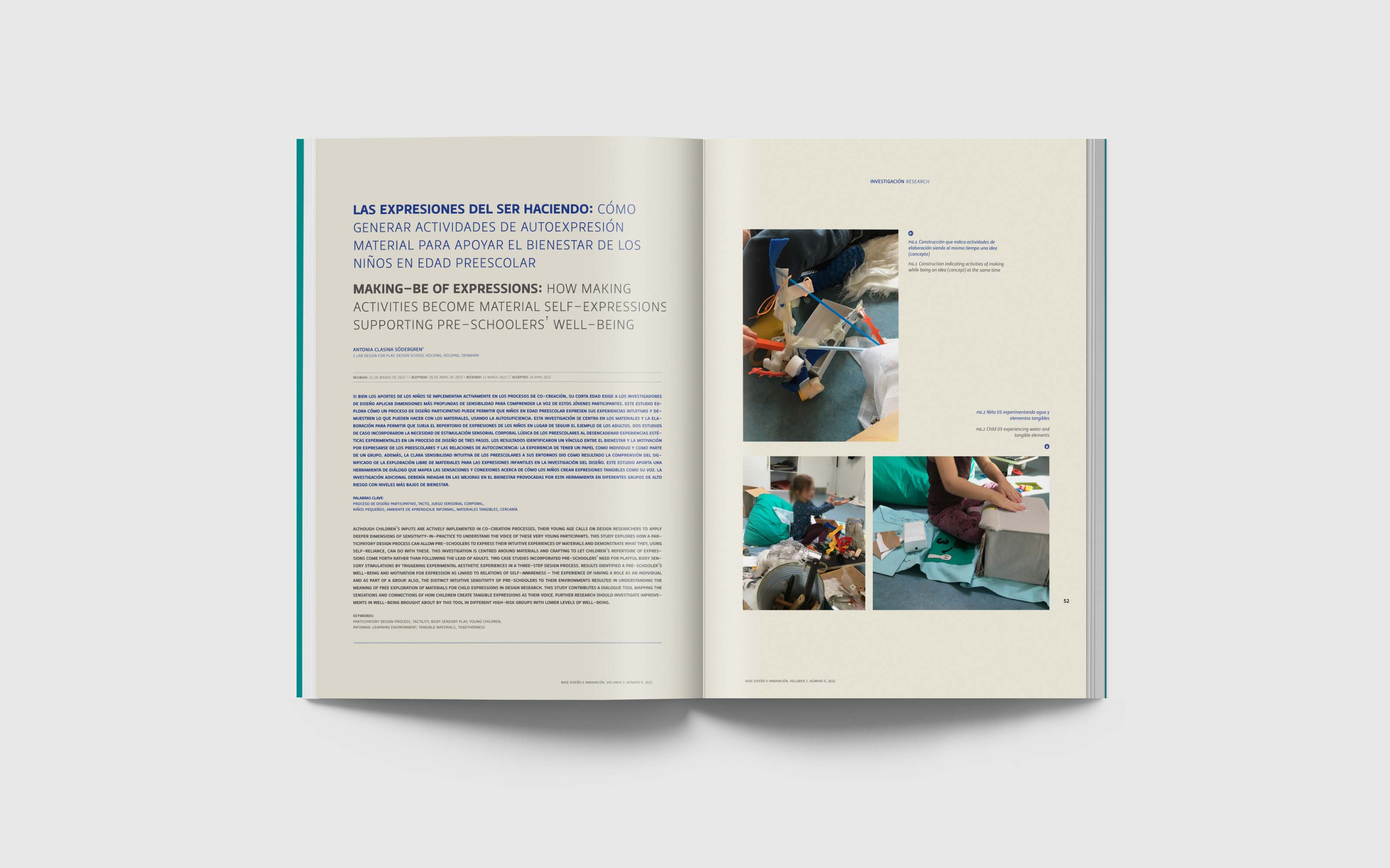Making-be of expressions How making activities become material self-expressions supporting pre-schoolers’ well-being
Main Article Content
Abstract
Although children’s inputs are actively implemented in co-creation processes, their young age calls on design researchers to apply deeper dimensions of sensitivity-in-practice to understand the voice of these very young participants. This study explores how a participatory design process can allow pre-schoolers to express their intuitive experiences of materials and demonstrate what they, using self-reliance, can do with these. This investigation is centred around materials and crafting to let children’s repertoire of expressions come forth rather than following the lead of adults. Two case studies incorporated pre-schoolers’ need for playful body sensory stimulations by triggering experimental aesthetic experiences in a three-step design process. Results identified a pre-schooler’s well-being and motivation for expression as linked to relations of self-awareness – the experience of having a role as an individual and as part of a group. Also, the distinct intuitive sensitivity of pre-schoolers to their environments resulted in understanding the meaning of free exploration of materials for child expressions in design research. This study contributes a dialogue tool mapping the sensations and connections of how children create tangible expressions as their ‘voice’. Further research should investigate improvements in well-being brought about by this tool in different high-risk groups with lower levels of well-being.
Article Details
References
Corbin, J. & Strauss, A. (2015). Basics of Qualitative Research – Techniques and Procedures for Developing Grounded Theory (4th ed.) Sage Publications.
Cross, N. (2011). Design Thinking. Berg Publishers.
Csikszentmihalyi, M. (1996). Creativity: flow and the psychology of discovery and invention (1st ed.) HarperCollins Publishers.
Desmet, P. & Hassenzahl, M. (2012). Towards Happiness: Possibility-Driven Design. In M. Zacarias & J. V. de Oliveira (Eds.), Human-Computer Interaction: The Agency Perspective: Vol 396. Studies in Computational Intelligence (pp.3-27) Springer. https://doi.org/10.1007/978-3-642-25691-2_1
Druin, A. (1999). Cooperative Inquiry: Developing New Technologies for Children with Children. In Proceedings of CHI’99 Pittsburgh PA USA. (pp. 592–599).
Fraiberg, S. (1959). De magiske år-den tidlige barndoms problemer. Hans Reitzel Forlag.
Gage, J. (2002). Colour and Meaning – Art, Science and Symbolism. Thames & Hudson.
Gielen, M. A. (2008). Exploring the child’s mind-context mapping research with children. Digital Creativity, 19(3), 174-184. https://doi.org/10.1080/14626260802312640
Guha, M. L., Druin, A., Chipman, G., Fails, J. A., Simms, S., & Farber, A. (2004, June). Mixing ideas: a new technique for working with young children as design partners. In IDC 2004 Proceedings of the 2004 conference on Interaction design and children: building a community (pp. 35-42). https://doi.org/10.1145/1017833.1017838
Hagen, J. Z. (2002). Filosofisk æstetik. Inføringer og tekster. Nordisk Forlag A/S.
Hammershøj, L. G. (2012). Kreativitet et spørgsmål om dannelse. Hans Reitzels Forlag.
Hart, S. (2018). Brain, Attachment, Personality. An introduction to neuroaffective development. Karnac Books.
Kress, G. & Van Leeuwen, T. (1996). Reading Images – The Grammar of Visual Design. Routledge.
Pink, S. (2015). Doing Sensory Ethnography (2nd ed.) Sage Publications.
Sanders, E. B.-N. (2006). Design Research in 2006. Design Research Quarterly, 1(1), 1–8.
Sanders, E. B.-N. & Stappers, P. J. (2012). Convivial Toolbox – Generative Research for the Front End of Design. BIS Publishers.
Saylor, M. M., Somander, M., Levin, D. T. & Kawamura, K. (2010). How do young children deal with hybrids of living and non-living things: The case of humanoid robots. British Journal of Developmental Psychology, 28(4), 835–851. https://doi.org/10.1348/026151009x481049
Slade, P. (1995). Child Play: Its Importance for Human Development. Jessica Kingsley Publishers.
Södergren, A.C. & Van Mechelen, M. (2019). Towards a child-led design process – A pilot study: when pre-schoolers’ play becomes designing. In IDC '19: Proceedings of the 18th ACM International Conference on Interaction Design and Children. (pp. 629–634) https://doi.org/10.1145/3311927.3325330
St George, J. M., Wroe, J. K. & Cashin, M. E. (2018). The concept and measurement of fathers’ stimulating play: a review. Attachment & human development, 20(6), 634–658. https://doi.org/10.1080/14616734.2018.1465106
Steenhold, J. M. (2018). Sanser og Sanselighed. Essays om den sansende viden. (2nd ed.). Excellent Play & Saxo Publish.
United Nations. (n.d.). The 17 goals. Retrieved February 27, 2022, from https://sdgs.un.org/goals.
Van Doorn, F., Gielen, M. & Stappers, J.P. (2013). Friends sharing opinions: Users become Co-researchers to Evaluate Design Concepts. In IASDR 2013: Proceedings of the 5th International Congress of International Association of Societies of Design Research" Consilience and Innovation in Design", Tokyo, Japan, 26-30 August 2013.
Wallin, K., Mæchel, I. & Barsotti, A. (1986). ‘Et barn har hundrede sprog. Om den skabende pædagogik på de kommunale daginstitutioner i Reggio Emilia’, Italien. V.U.M./Tvibis 1986.
Winnicott, D. W. (1971). Leg og virkelighed. Hans Reitzels Forlag.


